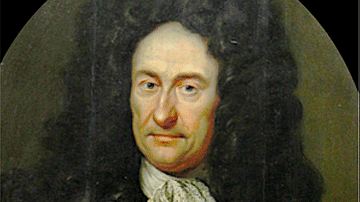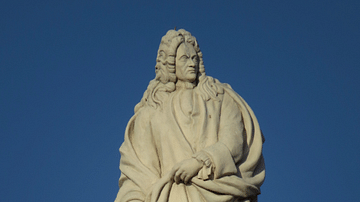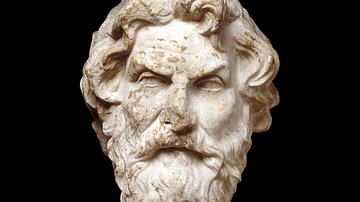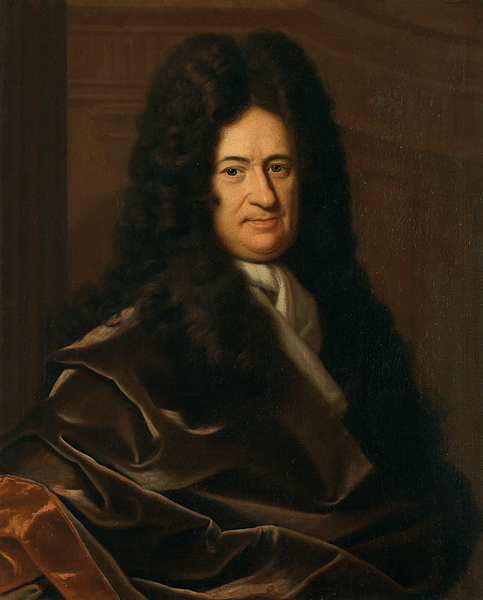
Gottfried Wilhelm Leibniz (1646-1716) was a German polymath who became well-known across Europe for his work, particularly in the fields of science, mathematics, and philosophy. Leibniz's rationalist philosophy attempted to reconcile traditional religious beliefs with the new discoveries of the Scientific Revolution, and his work was influential on later thinkers during the Enlightenment.
Early Life
Gottfried Wilhelm Leibniz was born in Leipzig on 1 July 1646. His father was a professor of moral philosophy at Leipzig's university. The young Gottfried learnt from his father's library and taught himself Latin, his studies continued with spells at Leibniz, Jena, and Altdorf universities where, in 1666, he concluded with a doctorate in law. Leibniz began his career as a secretary to a minister serving the Elector of Mainz in 1667. Working in this role for the next five years, Leibniz had the opportunity to travel across Europe, notably to England, France, Holland, and Italy. In 1677, Leibniz gained employment with the Duke of Brunswick-Lüneburg, where he performed various secretarial and advisory duties. He was appointed the duke's historian and librarian, a position he held for the rest of his life despite his foray into other fields like science, philosophy, mathematics, engineering, and even alchemy.
Leibniz developed such a wide array of intellectual pursuits that the historian H. Chisick notes that he was:
One of the most brilliant but least focussed minds of the early Enlightenment…He was a curious blend of courtier, administrator, political advisor and not infrequently pamphleteer, technical advisor, think-tanker and philosopher who recommended himself by his sheer intelligence and energy.
(245)
Leibniz endlessly flitted between projects, finding curious distractions in just about everything. He himself called his massive range of intellectual pursuits an "almost perpetual jumble" (Gottlieb, 165).
Mathematics
Mathematics was of serious interest to Leibniz. He worked on a calculating machine and, in the 1670s, he discovered the differential calculus (a mathematical tool for calculating curves and their areas). Well, it seemed he had but someone else rather famous thought he had not. The British scientist Isaac Newton (1642-1727) involved himself in a long-running feud with Leibniz, accusing the German of plagiarising his work on the calculus. In reality, both men had developed the calculus independently, and although most historians consider Newton to have got there first, Leibniz's version was superior. The favouring of Newton's calculus significantly held back mathematics in Britain.
Practical Science
Leibniz frequently left his library to indulge in some practical science. He worked on designs to improve coaches and on the problem of how to drain German silver mines (a mining problem which would kick off the British Industrial Revolution c. 1710). He designed a calculating machine that could perform both multiplications and divisions and drew up plans for a cypher machine that instantly put text into code. Leibniz, much like a mad inventor of popular fiction, was perpetually trying to improve things – he was, he said, motivated by helping the common good – whether it be the perfect recipe for brandy or a working submarine. He dabbled in extremely useful machines, ranging from desalination plants to utterly fanciful inventions like shoes with in-built springs to allow one to leap away with speed from a pursuer. Leibniz was, in most of these endeavours, trying to alleviate the three main causes of unhappiness as he saw them: poor education, unemployment, and poverty.
Physics and mechanics greatly interested him. Leibniz identified that for motion, the factors of quantity and force were quite separate. He coined the word "dynamics" and endorsed the idea of conservation of force when a body comes to rest, approaching the discovery of what we would later call kinetic energy. Leibniz was also something of a collector, and he built up fine personal collections of minerals and fossils.
Philosophy of Body & Mind
Leibniz expanded his more theoretical pursuits when in 1690 he was appointed the librarian of the Bibliotheca Augusta in Wolfenbüttel in Lower Saxony, Germany, still an important institution today. Always searching for improvements no matter the project, Leibniz planned for a vast new cataloguing system, but it turned out to be too expensive to become a reality. Leibniz was actually managing three libraries since on top of the Duke of Brunswick-Lüneburg's library and the Wolfenbüttel library, he had his own personal one with a not insignificant 6,000 volumes.

In 1695, Leibniz published his take on how the mind and body are connected. Leibniz called his theory a "new system of pre-established harmony" (Yolton, 279). He believed that while there is no physical connection between the mind and body, the physical world around us was so created by God that there is always some link between mental and physical events (things we experience) since the mind can dictate an action of the body and vice versa. For Leibniz, "the ultimate entities of reality are monads, 'simple substances' that combine to produce the world" (Burns, 167). Monads, then, from the Greek word for "unit", are the basic and individually isolated elements of reality which remain unaffected by each other and which are indivisible. Each monad is complete in itself and contains all the traces of the things that will ever happen to it. This was a bold new theory, but one that was far from easy to fully explain. Leibniz, like almost all other philosophers, attempted to make his theory clearer using analogies.
Leibniz suggests the body and mind are really like two clocks which operate independently but which are also synchronised. There is a sort of pre-established harmony between these two "clocks". In another analogy, Leibniz describes monads as:
[like] several different bands of musicians or choirs separately playing their parts, and placed in such a way that they do not see and do not even hear each other, though they nevertheless can agree perfectly, each following his own notes, so that someone hearing all of them would find a marvellous harmony there.
(Gottlieb, 169)
The cause which built the clocks/musicians/monads is God, and he knows all that is planned for each and every monad. God is, in fact, the supreme monad and the only one that has a relation with other monads, otherwise, monads never interconnect with each other. This is a fundamental cause upon which all Leibniz's other thoughts regarding philosophy are built. As the philosopher S. Blackburn explains:
The foundation of his thought is the conviction that to each individual there corresponds a complete notion, knowable only to God, from which is deductible all the properties possessed by the individual at each moment in its history.
(271)

Some critics have suggested that, because of the clock analogy, Leibniz favoured a purely mechanical view of the world (then a popular philosophy) and that his idea of humans as being like machines denied their free will. Leibniz believed, though, that mechanical philosophy needed a more spiritual element if it was to adequately explain human existence. His solution was to suggest that monads are not physical atoms but some sort of spiritual entity. His God monad provides the world with two causes: an efficient cause which drives monads on mechanically and a final cause which pulls the monads in the direction they are destined to follow. Leibniz, in his famous belief that every philosopher and every philosophy that has ever existed holds some truth, thus neatly melds the seemingly irreconcilable opposites of mechanical and metaphysical philosophy.
Leibniz believed that each individual is unique and that the actions of any single individual must have an effect on all other individuals since he viewed the universe as a logical and intelligible web of inter-connected events based on unchangeable laws. Leibniz was perhaps not entirely certain about God's role and influence on individuals except that he brings them into being and provides the necessary harmony of monads. Leibniz also believed that this world was the best possible one since God would not have made it otherwise (if he could not make a perfect world, then he cannot be himself perfect). Leibniz acknowledged that there was suffering in the world but that its purpose was beyond our understanding. Further, Leibniz defines the world's perfection as "the combination of the maximum diversity of phenomena with the maximum simplicity of laws" (Burns, 168). He believed the universe was infinite since God would not be limited and the idea matched that of a "best of all possible worlds" (Burns, 151). He considered matter was infinite, too, a point which therefore denied the possibility of vacuums, a hot topic for scientists of the period.
Leibniz believed that individuals are born with certain faculties with which they can deal with the world. These faculties are not well-defined but rather, as Isaiah Berlin phrases it, are "like veins in the marble which the sculptor must take into account, and which form its character whether he does so or not" (39). In this analogy then, the sculptor is the practical experience so favoured by the empiricists. Leibniz, then, proposed a position between those thinkers who believed we are born with innate ideas and those who believed these ideas are only acquired through experience. Leibniz proposes two categories of facts: those known through reason and those known through the experience of the senses (which are less reliable).
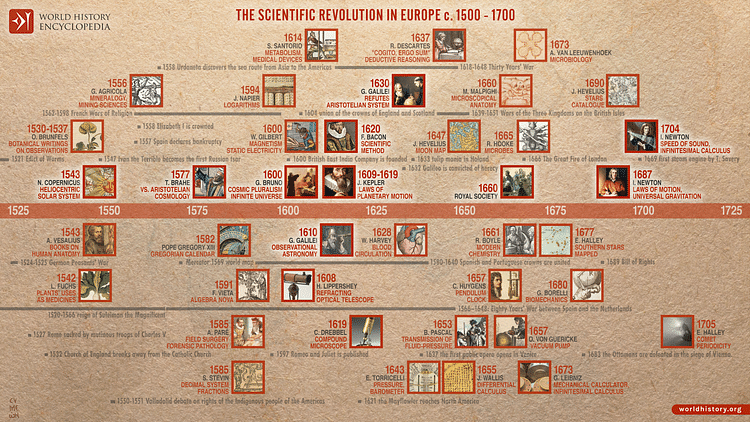
International Academies
In 1700, Leibniz was appointed the first president of the Berlin Academy of Science, an institution he had significantly helped to found. This was something of a hat-trick achievement since he was already a member of both the Royal Academy of Sciences in Paris and the Royal Society in London, which had been impressed with his calculating machine. He did not stop there and continued to be instrumental in the coordination of intellectual achievement by promoting the foundation of academies in Vienna and St. Petersburg. Leibniz often had his writings presented at these various and prestigious academies and regularly incorporated many of his essays into their printed journals. This wider publication was made possible because Leibniz usually wrote in either Latin or French, then the most used languages amongst intellectuals.
Leibniz's Major Works
Leibniz focussed on journal articles to make his work more widely known, publishing in such periodicals as the Journal des sçavans. He also presented his ideas in letters, keeping up a regular correspondence with certain fellow thinkers abroad, notably Samuel Clarke (1675-1729), regarded by most historians as acting here for his close friend Isaac Newton. Leibniz wrote at least 15,000 letters, and his correspondence with specific thinkers has been published in various themed collections. Leibniz's major books include:
Discourse of Metaphysics (1686)
The New System (1695)
Essays on Theodicy (1710)
Monadology (1713)
Death & Legacy
Writing and working until the end, Leibniz even received an income from the St. Petersburg court as his reputation as one of Europe's foremost thinkers spread far and wide. Leibniz died in Hanover on 14 November 1716. He had never married and had no children.
The importance of metaphysics to Leibniz's philosophy led to him being discarded and criticised by those Enlightenment philosophers who favoured empiricism as the best way to understand the world around us. The empiricists found serious fault with what they called Leibniz's optimism (then a term that meant one believed the world could not be better than it is). The most infamous attack came in the satirical Candide by Voltaire (1694-1778), where the rather gullible central character is essentially based on Leibniz.
Leibniz's theorationalism and logical analysis of age-old philosophical problems did, however, influence some other and highly gifted thinkers of the Enlightenment, particularly David Hume (1711-1776) and Immanuel Kant (1724-1804). Kant described Leibniz's unusual metaphysical theory as "a sort of enchanted world" (Gottlieb, 168). Another thinker who was particularly influenced by Leibniz was Christian Wolff (1679-1754).

Leibniz has his name attached to several principles of philosophy. The Principle of Sufficient Reason stipulates that there is a sufficient reason for all existing things, or to put it another way, nothing happens without a reason. The Principle of the Identity of Indiscernibles states that "there cannot be two things that differ only in number" (Yolton, 280), or to put it another way, "if A and B have exactly the same properties, then they are identical" (Blackburn, 234), or to put it a third way, A and B must actually be the same thing (there cannot be two). The opposite position is the Principle of Indiscernibility of Identicals, also known as Leibniz's law (a term sometimes used for both principles together): "if A is identical with B, then every property that A has B has, and vice versa" (ibid, 242). These principles are often used by philosophers in discussions which demonstrate or question whether two things are the same or not, for example, the debate as to whether the human brain is the same as the mind or different. By examining the properties of both and seeing which properties or if all properties belong to both, the philosopher can make a decision as to whether there are two different things or one thing. Another lasting legacy of Leibniz's work is his development of binary arithmetic, the strings of 1 and 0 so essential to modern computers.
Perhaps Leibniz's most lasting legacy is his inspirational example as someone who took great interest in, quite literally, everything. As W. E. Burns notes "Leibniz has often been described as the last man knowledgeable in all branches of knowledge" (167). The historian A. Gottlieb concurs and boldly states that Leibniz "was the greatest polymath since Aristotle" (163). Certainly, many other thinkers were in awe of Leibniz. Denis Diderot (1713-1784) once stated: "When one compares one's own talents with those of Leibniz it is tempting to throw away one's books and go off to die in some quiet corner" (Gottlieb, 163).
Leibniz, above all, gives grounds for optimism for other thinkers through his never-ending search for the interconnectedness of human knowledge, his belief that religion and science can be reconciled, and his encouragement that "Truth is more widespread than people think" and that "things are bound to progress for the better, whether gradually or sometimes even by leaps and bounds" (Gottlieb, 177 & 195).



